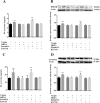Role of vaspin in porcine ovary: effect on signaling pathways and steroid synthesis via GRP78 receptor and protein kinase A†
- PMID: 32149334
- PMCID: PMC7703729
- DOI: 10.1093/biolre/ioaa027
Role of vaspin in porcine ovary: effect on signaling pathways and steroid synthesis via GRP78 receptor and protein kinase A†
Abstract
Vaspin, visceral-adipose-tissue-derived serine protease inhibitor, is involved in the development of obesity, insulin resistance, inflammation, and energy metabolism. Our previous study showed vaspin expression and its regulation in the ovary; however, the role of this adipokine in ovarian cells has never been studied. Here, we studied the in vitro effect of vaspin on various kinase-signaling pathways: mitogen-activated kinase (MAP3/1), serine/threonine kinase (AKT), signal transducer and activator of transcription 3 (STAT3) protein kinase AMP (PRKAA1), protein kinase A (PKA), and on expression of nuclear factor kappa B (NFKB2) as well as on steroid synthesis by porcine ovarian cells. By using western blot, we found that vaspin (1 ng/ml), in a time-dependent manner, increased phosphorylation of MAP3/1, AKT, STAT3, PRKAA1, and PKA, while it decreased the expression of NFKB2. We observed that vaspin, in a dose-dependent manner, increased the basal steroid hormone secretion (progesterone and estradiol), mRNA and protein expression of steroid enzymes using real-time PCR and western blot, respectively, and the mRNA of gonadotropins (FSHR, LHCGR) and steroids (PGR, ESR2) receptors. The stimulatory effect of vaspin on basal steroidogenesis was reversed when ovarian cells were cultured in the presence of a PKA pharmacological inhibitor (KT5720) and when GRP78 receptor was knocked down (siRNA). However, in the presence of insulin-like growth factor type 1 and gonadotropins, vaspin reduced steroidogenesis. Thus, vaspin, by activation of various signaling pathways and stimulation of basal steroid production via GRP78 receptor and PKA, could be a new regulator of porcine ovarian function.
Keywords: kinases; ovary; pig; steroid hormones; vaspin.
© The Author(s) 2020. Published by Oxford University Press on behalf of Society for the Study of Reproduction. All rights reserved. For permissions, please e-mail: journals.permissions@oup.com.
Figures








Similar articles
-
Review: Vaspin (SERPINA12) Expression and Function in Endocrine Cells.Cells. 2021 Jul 6;10(7):1710. doi: 10.3390/cells10071710. Cells. 2021. PMID: 34359881 Free PMC article. Review.
-
Expression and Impact of Vaspin on In Vitro Oocyte Maturation through MAP3/1 and PRKAA1 Signalling Pathways.Int J Mol Sci. 2020 Dec 8;21(24):9342. doi: 10.3390/ijms21249342. Int J Mol Sci. 2020. PMID: 33302416 Free PMC article.
-
In Vitro Effects of Vaspin on Porcine Granulosa Cell Proliferation, Cell Cycle Progression, and Apoptosis by Activation of GRP78 Receptor and Several Kinase Signaling Pathways Including MAP3/1, AKT, and STAT3.Int J Mol Sci. 2019 Nov 19;20(22):5816. doi: 10.3390/ijms20225816. Int J Mol Sci. 2019. PMID: 31752432 Free PMC article.
-
The role of vaspin in porcine corpus luteum.J Endocrinol. 2020 Dec;247(3):283-294. doi: 10.1530/JOE-20-0332. J Endocrinol. 2020. PMID: 33108345
-
New insights into cell apoptosis and proliferation: the potential role of vaspin.J Physiol Pharmacol. 2021 Dec;72(6). doi: 10.26402/jpp.2021.6.02. Epub 2022 Apr 2. J Physiol Pharmacol. 2021. PMID: 35377336 Review.
Cited by
-
Review: Vaspin (SERPINA12) Expression and Function in Endocrine Cells.Cells. 2021 Jul 6;10(7):1710. doi: 10.3390/cells10071710. Cells. 2021. PMID: 34359881 Free PMC article. Review.
-
Expression and Impact of Vaspin on In Vitro Oocyte Maturation through MAP3/1 and PRKAA1 Signalling Pathways.Int J Mol Sci. 2020 Dec 8;21(24):9342. doi: 10.3390/ijms21249342. Int J Mol Sci. 2020. PMID: 33302416 Free PMC article.
-
New aspect on the regulation of in vitro oocyte maturation: role of the obesity, neuropeptides and adipokines.J Assist Reprod Genet. 2025 Mar;42(3):737-752. doi: 10.1007/s10815-024-03345-w. Epub 2024 Dec 13. J Assist Reprod Genet. 2025. PMID: 39671071 Review.
-
Plasma level and expression of visfatin in the porcine hypothalamus during the estrous cycle and early pregnancy.Sci Rep. 2021 Apr 22;11(1):8698. doi: 10.1038/s41598-021-88103-z. Sci Rep. 2021. PMID: 33888798 Free PMC article.
-
The Role of Selected Adipocytokines in Ovarian Cancer and Endometrial Cancer.Cells. 2023 Apr 9;12(8):1118. doi: 10.3390/cells12081118. Cells. 2023. PMID: 37190027 Free PMC article. Review.
References
-
- Hida K, Wada J, Eguchi J, Zhang H, Baba M, Seida A, Hashimoto I, Okada T, Yasuhara A, Nakatsuka A, Shikata K, Hourai S et al. Visceral adipose tissue-derived serine protease inhibitor: a unique insulin-sensitizing adipocytokine in obesity. Proc Natl Acad Sci USA 2005; 102:10610–10615. - PMC - PubMed
-
- Li Q, Chen R, Moriya J, Yamakawa J, Sumino H, Kanda T, Takahashi T. A novel adipocytokine, visceral adipose tissue-derived serine protease inhibitor (vaspin), and obesity. J Int Med Res 2008; 36:625–629. - PubMed
-
- Klöting N, Kovacs P, Kern M, Heiker JT, Fasshauer M, Schön MR, Stumvoll M, Beck-Sickinger AG, Blüher M. Central vaspin administration acutely reduces food intake and has sustained blood glucose-lowering effects. Diabetologia 2011; 54:1819–1823. - PubMed
-
- Lai X, Zhang C, Wang J, Wang C, Lan X, Zhang C, Lei C, Chen H. mRNA expression pattern and association study with growth traits of bovine vaspin gene. Mol Biol Rep 2013; 40:4499–4505. - PubMed
-
- Youn BS, Klöting N, Kratzsch J, Lee N, Park JW, Song ES, Ruschke K, Oberbach A, Fasshauer M, Stumvoll M, Blüher M. Serum vaspin concentrations in human obesity and type 2 diabetes. Diabetes 2008; 57:372–377. - PubMed
Publication types
MeSH terms
Substances
LinkOut - more resources
Full Text Sources
Research Materials
Miscellaneous

